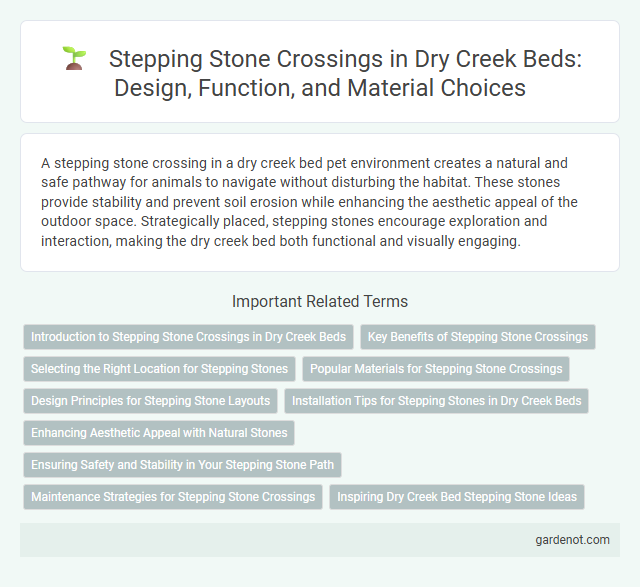A stepping stone crossing in a dry creek bed pet environment creates a natural and safe pathway for animals to navigate without disturbing the habitat. These stones provide stability and prevent soil erosion while enhancing the aesthetic appeal of the outdoor space. Strategically placed, stepping stones encourage exploration and interaction, making the dry creek bed both functional and visually engaging.
Introduction to Stepping Stone Crossings in Dry Creek Beds
Stepping stone crossings in dry creek beds provide a practical and eco-friendly method for pedestrians to traverse uneven or waterless channels. These crossings consist of strategically placed flat stones that offer stable footing, minimizing soil disturbance and preserving the natural landscape. Their design enhances safety and accessibility while maintaining the creek bed's ecological integrity.
Key Benefits of Stepping Stone Crossings
Stepping stone crossings provide a natural and eco-friendly way to traverse dry creek beds without disturbing the surrounding ecosystem or altering water flow patterns. These crossings enhance safety by offering stable, slip-resistant surfaces that reduce the risk of falls while maintaining aesthetic harmony with the natural landscape. Implementing stepping stone crossings supports effective water drainage and soil preservation, preventing erosion and promoting habitat continuity.
Selecting the Right Location for Stepping Stones
Choosing the right location for a stepping stone crossing in a dry creek bed involves identifying stable, level ground with minimal flow during rains to ensure safety and durability. Stones should be placed where natural rock formations or compacted soil provide firm support, avoiding areas prone to erosion or sediment buildup. Proper spacing between stones, typically 12 to 18 inches apart, allows comfortable and secure foot placement while maintaining the aesthetic harmony of the creek bed landscape.
Popular Materials for Stepping Stone Crossings
Popular materials for stepping stone crossings in dry creek beds include natural stone, such as flagstone and slate, prized for durability and aesthetic appeal. Concrete stepping stones are also common due to their versatility and ability to mimic natural textures. Wood and recycled materials provide eco-friendly alternatives, blending seamlessly into the natural landscape while supporting sustainable design.
Design Principles for Stepping Stone Layouts
Effective stepping stone crossing design involves strategic placement based on natural water flow and user safety, ensuring stones are spaced to allow comfortable footing while minimizing water disruption. Optimal layouts consider stone size, shape, and surface texture to enhance grip and stability, adapting to varying water levels and flow rates. Integrating natural materials and aligning stones with the creek's topography supports environmental harmony and durability in dry creek bed crossings.
Installation Tips for Stepping Stones in Dry Creek Beds
For effective installation of stepping stones in dry creek beds, choose flat, durable stones such as flagstone or concrete pavers to ensure stability and safety. Prepare the site by clearing debris and leveling the ground, then set the stones partially into the soil to prevent shifting during heavy rains. Embed the stones with a layer of sand or gravel underneath to improve drainage and reduce erosion in the dry creek bed area.
Enhancing Aesthetic Appeal with Natural Stones
Stepping stone crossings in dry creek beds enhance aesthetic appeal by integrating natural stones that complement the surrounding landscape's texture and color. Carefully selected stones with varying shapes and sizes create a harmonious visual flow while providing functional pathways across the dry bed. The use of indigenous stones promotes ecological balance and ensures long-lasting durability in outdoor environments.
Ensuring Safety and Stability in Your Stepping Stone Path
Proper installation of stepping stones in a dry creek bed involves securing each stone on a firm, leveled base with compacted gravel or sand to prevent shifting and instability. Choose stones with a rough texture and irregular shapes to enhance traction and reduce slipping hazards, especially after rain. Regularly inspect and adjust the stones to maintain even spacing and alignment, ensuring a safe and stable crossing path.
Maintenance Strategies for Stepping Stone Crossings
Regular inspection of stepping stone crossings in dry creek beds prevents debris buildup and erosion, ensuring safety and longevity. Applying sealants and replacing worn stones maintain structural integrity and reduce slip hazards. Strategic vegetation control around crossing points minimizes root damage and stabilizes the creek bed environment.
Inspiring Dry Creek Bed Stepping Stone Ideas
Stepping stone crossings transform dry creek beds into functional and aesthetic pathways, blending natural stones with surrounding landscapes. Incorporate varied stone sizes and textures to create an artistic, safe, and visually engaging route that mimics natural water flow. These ideas enhance garden accessibility while emphasizing organic design elements, making dry creek beds a focal point in outdoor spaces.
Stepping stone crossing Infographic

 gardenot.com
gardenot.com